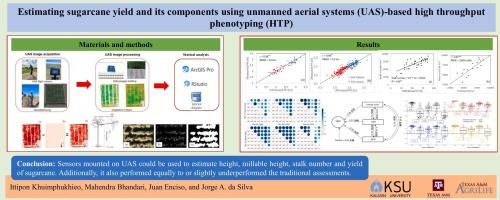基于无人机系统(UAS)的高通量表型(HTP)估算甘蔗产量及其组成部分
IF 8.9
1区 农林科学
Q1 AGRICULTURE, MULTIDISCIPLINARY
引用次数: 0
摘要
产量及其构成因素是植物育种人员在育种计划中选择最佳基因型的重要性状。然而,传统的跨基因型和环境测量这些性状是劳动密集型和耗时的,因为需要估计数百甚至数千个地块。以7个甘蔗品种为试验材料,采用随机完全区组设计,4个重复种植2种再生作物,利用基于无人机系统(UAS)的高通量表型(HTP)估算甘蔗产量及其组成部分,并通过通径系数分析比较传统方法与基于无人机系统(UAS)的产量组成部分对甘蔗产量的判别能力。装有传感器的无人机平台在试验上空飞行。结果表明,uas计算的株高(PH)与地面实测PH呈极显著相关(R2 = 0.89, RMSE = 0.15 m)。同样,使用uas衍生的PH值作为预测因子,观察到准确的可millable茎秆高度(MSH)估计(R2 = 0.54, RMSE = 0.15 m)。冠层高度模型(CHM)衍生的冠层盖度(CC)似乎是间接选择或预测茎数(SN)的一个有希望的特征(R2 = 0.69, RMSE = 10,975秸秆ha−1)。基于通径系数分析,基于uas的产量成分的表现与传统方法相同或略低于传统方法。传统上,snn是甘蔗产量的最大贡献者。同样,CC和CHM是基于uas的产量成分的重要组成部分。此外,利用uas衍生的冠层特征和5种交叉验证方案(cv)建立的产量预测模型表明,随着预测变量与响应变量之间相关性的增加,模型的准确性也会提高。目前的研究表明,随机森林在所有cv中都优于线性回归模型(逐步回归模型、套索模型和山脊模型)(更高r和更低RMSE)。当线性回归用于预测未测试作物/环境(CVs2和CVs5)中品种的表现时,线性回归是关闭的,而在这些cv中使用随机森林时观察到更高的准确性。更重要的是,在未经测试的作物/环境(CVs2和CVs5)中测试时,所有模型的准确性都降低了,这表明将预测模型应用于新环境存在挑战。本文章由计算机程序翻译,如有差异,请以英文原文为准。

Estimating sugarcane yield and its components using unoccupied aerial systems (UAS)-based high throughput phenotyping (HTP)
Yield and its components are the important traits for plant breeders to select the best genotypes in the breeding programs. However, traditional measurements of these traits across genotypes and environments are labor-intensive and time-consuming, as hundreds or even thousands of plots need to be estimated. A yield trial was carried out using seven sugarcane cultivars planted in a randomized complete block design with four replications for two ratoon crops to estimate sugarcane yield and its components using unoccupied aerial systems (UAS)-based high throughput phenotyping (HTP) and to compare the traditional method with UAS-based yield components in discriminating ability to assess sugarcane yield via a path coefficient analysis. UAS platforms mounted with sensors were flown over the trial. The result shows that UAS-derived plant height (PH) showed a strong relationship with the ground measured PH (R2 = 0.89, RMSE = 0.15 m). Likewise, an accurate millable stalk height (MSH) estimation, using UAS-derived PH as a predictor, was observed (R2 = 0.54, RMSE = 0.15 m). Canopy height model (CHM)-derived canopy cover (CC) appeared to be a promising feature to indirectly select or to predict for stalk number (SN) (R2 = 0.69, RMSE = 10,975 stalks ha−1). Based on a path coefficient analysis, UAS-based yield components performed equally to or slightly underperformed the traditional method. Traditionally, SN was the largest contributor to cane yield. Similarly, CC and CHM were the important components for UAS-based yield components. Additionally, the yield prediction model using UAS-derived canopy features with five cross validation schemes (CVs) revealed that model accuracy increased as association between predictor variables with a responding variable increased. The present study shows that random forest outperformed (higher r and lower RMSE) the linear regression models (stepwise, lasso, and ridge) in all CVs. The linear regressions were off when they were used to predict the performance of cultivars in untested crop/environments (CVs2 and CVs5), while a higher accuracy was observed when using random forest in those CVs. More importantly, the accuracy of all models reduced when they were tested in untested crop/environments (CVs2 and CVs5), indicating the challenge of using a prediction model applied to new environments.
求助全文
通过发布文献求助,成功后即可免费获取论文全文。
去求助
来源期刊

Computers and Electronics in Agriculture
工程技术-计算机:跨学科应用
CiteScore
15.30
自引率
14.50%
发文量
800
审稿时长
62 days
期刊介绍:
Computers and Electronics in Agriculture provides international coverage of advancements in computer hardware, software, electronic instrumentation, and control systems applied to agricultural challenges. Encompassing agronomy, horticulture, forestry, aquaculture, and animal farming, the journal publishes original papers, reviews, and applications notes. It explores the use of computers and electronics in plant or animal agricultural production, covering topics like agricultural soils, water, pests, controlled environments, and waste. The scope extends to on-farm post-harvest operations and relevant technologies, including artificial intelligence, sensors, machine vision, robotics, networking, and simulation modeling. Its companion journal, Smart Agricultural Technology, continues the focus on smart applications in production agriculture.
 求助内容:
求助内容: 应助结果提醒方式:
应助结果提醒方式:


